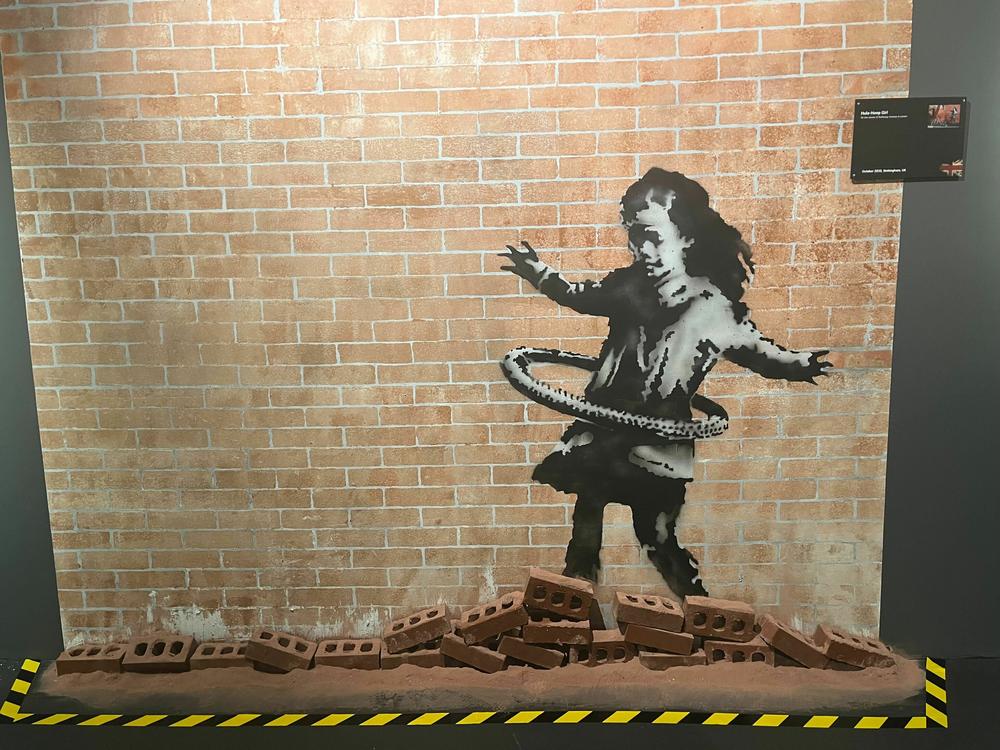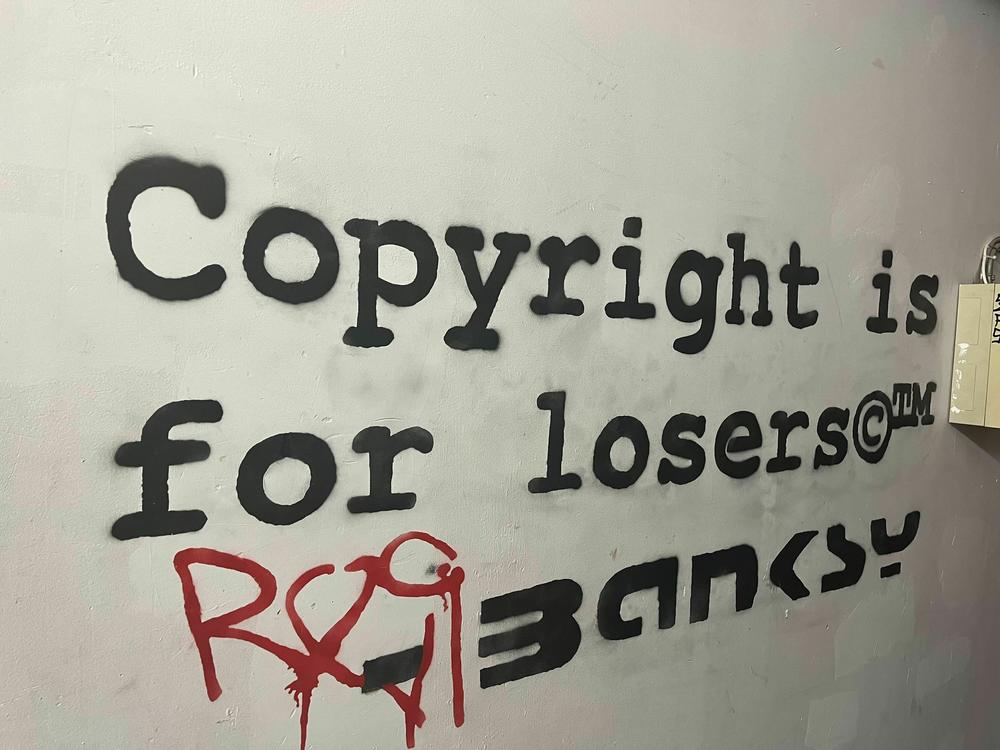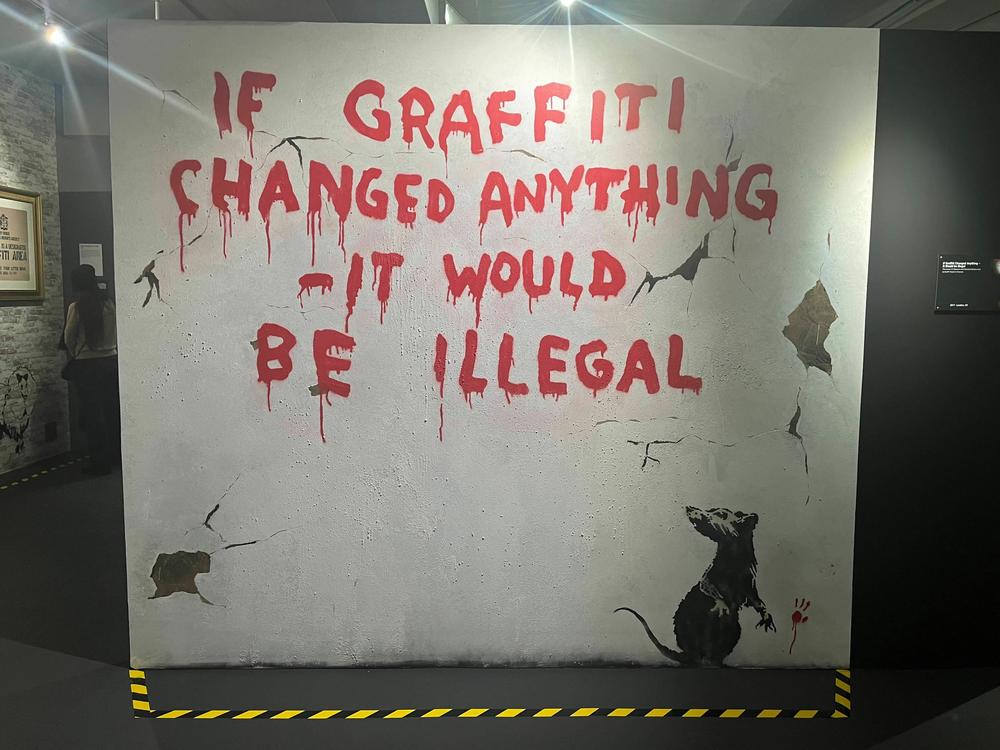Section Branding
Header Content
A new Banksy Museum has opened in NYC … minus Banksy
Primary Content
The new Banksy Museum in New York City tries to recreate the experience of stumbling upon Banksy graffiti in the wild. There is a fake manhole cover here, artfully-arranged debris there, and wall after wall fabricated to look like brick or concrete and stenciled with Banksy’s iconic pictures of children, police officers and rats.
But there’s a catch — these are not real Banksys, and Banksy never agreed to have his work reproduced.
Museum founder Hazis Vardar, who privately collects original Banksys and opened a museum of replicas in Paris several years ago, said he isn’t worried about the artist’s lack of involvement.
“Banksy changed the rules. If you want to organize something about Banksy, you have to change the rules also,” he said on a recent walk through the exhibit.
Vardar described Banksy as a pirate, and said he identifies with that. “Pirate” might be a good description. For decades, the British street artist has harnessed his anonymity, surprising city dwellers and the art world with his satiric murals and pop-up exhibits that appear suddenly overnight.
But because much of Banksy’s graffiti is created on walls and buildings that don’t belong to the artist, they’re technically vandalism — and they’re often damaged by weather, painted over by other people, or sold to private galleries and collectors.
“Sometimes the cleaning team of the city, they just clean over it in the morning,” said Vardar. In his mind, the Banksy Museum preserves Banksy’s work for the sake of the public.
But that’s not how Leila Amineddoleh, an art and intellectual property attorney, sees it.
“There are tons of replicas of the Mona Lisa, and that’s not preserving the original,” she said. “I would argue the same for Banksy.”
Many of Banksy’s pieces are site-specific, with a particular context in mind. For example, the museum reproduces an image of a young girl floating away as she holds onto a handful of balloons that was originally painted on the West Bank barrier wall and seemed to comment on the plight of Palestinians. Amineddoleh argued that by taking art like that indoors and charging a $30 entrance fee, the museum not only changes the meaning, but undercuts Banksy’s core mission.
“The subversion, making his message available to the public for free, that’s a really important part of Banksy’s message,” she said.
The artist has already said no — kind of
Banksy has already made it clear he doesn’t want his work used in this way. Pest Control, the company that manages Banksy’s licensing, has denounced on its website anyone who makes a profit off the artist’s work. And in his Academy Award-nominated 2010 documentary Exit Through the Gift Shop, the artist criticized the commercialization of street art. In one of the museum’s staircases, there’s a Banksy quote painted on the wall that reads “Copyright is for losers.”
Neither Pest Control nor Banksy responded to requests for comment on Vardar’s exhibitions. But Amineddoleh said that while Banksy’s opinions on licensing and intellectual property are part of what makes him such an interesting artist, it doesn’t change how the law applies to him.
“He automatically had a copyright when he created this artwork,” she said. “The fact that he doesn’t like copyright doesn’t really make a difference.”
What’s a little more complicated, she said, is how another law, the Visual Artists Rights Act (VARA) might apply to a street artist like Banksy. If any of the works in the museum were created on property owned by the artist, he could have a case under VARA to have his name removed from the unauthorized versions in Vardar’s museum. But that law has not been tested on vandalism, said Amineddoleh, so it’s hard to know whether or not it would extend Banksy any protections on pieces he doesn’t technically own.
Vardar’s response: if Banksy has any issues with the museum, he could sue.
Why doesn’t Banksy bring museums like this to court?
“The issue is Banksy never wants to sue because he tries to conceal his identity, and I think that’s one of the reasons he’s become so popular,” said Amineddoleh. “There’s this mystique around who he is, and if he destroys that mystique, maybe he would be destroying some of the value of his art.”
For now, no lawsuit means the Banksy Museum can keep its doors open for as long as people show up.
But those visitors won’t include people like Brooklyn Street Art founders Jaime Rojo and Steven P. Harrington. Over email, the men, whose organization preserves and documents street art, said they found the use of the word museum humorous and that they cannot take any Banksy exhibition unauthorized by the artist seriously.
“This newest iteration is a sizable stretch in credulity, with promoters saying that anonymous artists from the UK have recreated Banksy's work,” they wrote. “In another field, those people are called commercial artists or decorative painters — no different from recreating Michelangelo's ‘Creation of Adam’ on the wall in a pizza parlor.”
The audio and digital versions of this story were edited by Jennifer Vanasco.




